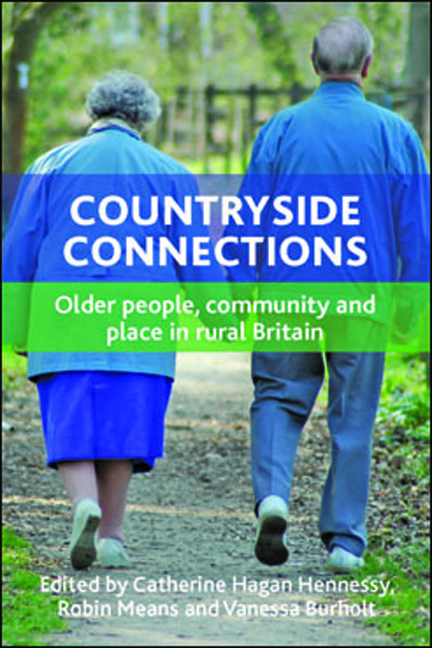Book contents
- Frontmatter
- Contents
- List of tables and figures
- Acknowledgements
- Notes on contributors
- Foreword
- one Countryside connections in later life: setting the scene
- two Conceptualising rural connectivities in later life
- three Rural connectivity and older people’s leisure participation
- four Connecting with community: the nature of belonging among rural elders
- five Beyond transport: understanding the role of mobilities in connecting rural elders in civic society
- six Deep mapping and rural connectivities
- seven Older people, low income and place: making connections in rural Britain
- eight Connecting with older people as project stakeholders: lessons for public participation and engagement in rural research
- nine Towards connectivity in a Grey and Pleasant Land?
- Index
nine - Towards connectivity in a Grey and Pleasant Land?
Published online by Cambridge University Press: 04 March 2022
- Frontmatter
- Contents
- List of tables and figures
- Acknowledgements
- Notes on contributors
- Foreword
- one Countryside connections in later life: setting the scene
- two Conceptualising rural connectivities in later life
- three Rural connectivity and older people’s leisure participation
- four Connecting with community: the nature of belonging among rural elders
- five Beyond transport: understanding the role of mobilities in connecting rural elders in civic society
- six Deep mapping and rural connectivities
- seven Older people, low income and place: making connections in rural Britain
- eight Connecting with older people as project stakeholders: lessons for public participation and engagement in rural research
- nine Towards connectivity in a Grey and Pleasant Land?
- Index
Summary
Introduction
We have seen how the Grey and Pleasant Land (GaPL) research project was based on an interdisciplinary collaboration that brought together two dozen researchers at five universities to study the civic and social lives of older people in six different rural communities in England and Wales. As explained in Chapter One by Hennessy, Means and Burholt, we followed an approach in which the cross-cutting theme of connectivity was used as a ‘heuristic metaphor’ (Klamor and Leonard, 1994), with the aim of facilitating shared theorising through the collective adoption of this shared concept. This chapter, therefore, starts with some reflections on the challenges and rewards of interdisciplinary research on rural ageing.
During the life of the project, the popularity of the term ‘connectivity’ took off in assorted policy and research funding arenas, as exemplified in the UK Research Councils’ interdisciplinary programme on Connected Communities. This chapter argues that the exploratory power of connectivity makes it much more than a heuristic device. Drawing upon the previous chapters, the diverse ways in which rural elders connect will be illustrated, as well as the main barriers to such connectivity taking place. It will be argued that it is important to understand the distinction between how rural elders experience connectivity to people in such areas as civic engagement and intergenerational relations as opposed to their connectivity to objects (eg landscape and scenery). It will also be argued that connection to place still matters to many rural elders but that, overall, they are starting to transition from place-based to more geographically dispersed connectivity.
The chapter also revisits how best to theorise connectivity by looking at what Chapters Three to Eight tell us about the explanatory power of both the social capital and human ecology perspectives. It concludes by drawing out broad policy and practice implications for rural stakeholders and arguing that the overall findings do challenge the dominant problem-based paradigm for rural elders.
The challenge and rewards of interdisciplinary research on rural ageing
What does the literature on interdisciplinary research tell us?
Large-scale multidisciplinary and interdisciplinary research is increasingly advocated by governments and the major research funders like Research Councils UK, with the present Strategic Vision of the latter stressing the need ‘to maximise opportunities for breakthrough research that crosses disciplines and domain boundaries’ (RCUK, 2011, p 3).
- Type
- Chapter
- Information
- Countryside ConnectionsOlder People, Community and Place in Rural Britain, pp. 245 - 276Publisher: Bristol University PressPrint publication year: 2014

